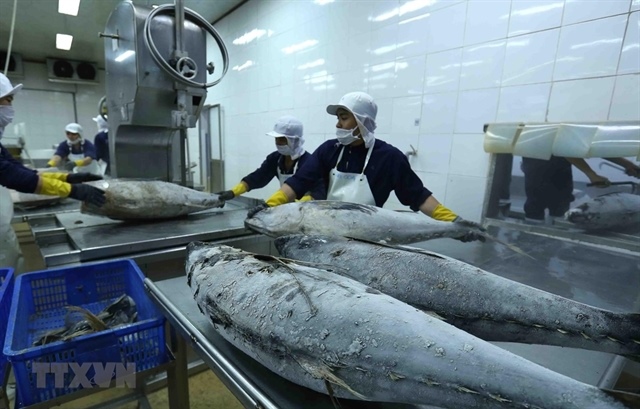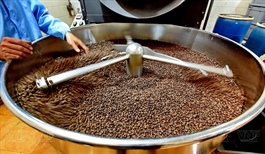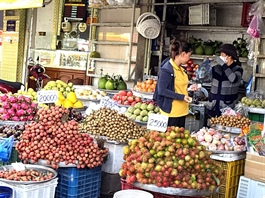VASEP: global tuna market enters period of major transformation
VASEP: global tuna market enters period of major transformation
A notable trend this year is the shift from raw material imports to deep processing orders, with countries like Việt Nam, Thailand, the Philippines, and Indonesia becoming central players in the global tuna supply chain.

Fishermen in Gia Lai Province catch tuna. — Photo kinhtedothi.vn |
The global tuna market is undergoing a significant transformation, according to the latest report from the Vietnam Association of Seafood Exporters and Producers (VASEP).
Global tuna imports are expected to reach between 1.75 and 1.8 million tonnes in 2025, with a total value exceeding US$9 billion, marking a slight increase compared to 2024. While raw tuna prices remain elevated, demand from key markets such as the US, the EU and Japan continues to hold steady.
The US, Spain, Italy, France, the UK and Japan remain the top importers of processed tuna, collectively accounting for over 55 per cent of total global imports. Meanwhile, emerging markets such as Egypt, Lebanon, Lithuania, Romania and Libya are showing notable growth, driven by rising demand for convenient food products and competitive pricing.
A notable trend this year is the shift from raw material imports to deep processing orders, with countries like Việt Nam, Thailand, the Philippines and Indonesia becoming central players in the global tuna supply chain. These nations are increasingly responsible for delivering value-added products to meet evolving market demands.
As per the report, Asia continues to serve as a critical hub for tuna production and processing. However, suppliers across the region are facing mounting pressure to raise quality standards, ensure full traceability, and comply with internationally recognised sustainability certifications such as MSC (Marine Stewardship Council), Dolphin Safe and stringent EU and US regulatory frameworks.
A standout feature of 2025 is the industry’s pivot toward premium, value-added offerings. Frozen tuna loins, sashimi-grade cuts, ready-to-eat meals and vacuum-packed products are gaining traction. Major retail chains in the US, the EU and Japan are ramping up the distribution of these items to align with consumer preferences for health-conscious, convenient food options.
Beyond market dynamics, tuna exporters are also navigating external pressures, including geopolitical instability in the Middle East and changing trade policies, particularly in the US. Higher import taxes on certain product categories are driving up costs and forcing exporters to adapt quickly, the report revealed.
According to the report, traceability requirements have become the new industry standard. Many businesses are investing in technologies such as QR codes, blockchain systems and real-time tracking, from fishing vessels to factories and retail shelves.
It said that while 2025 may not see a surge in output, it marks a critical structural turning point for the tuna industry. Success in this new landscape will depend less on price and more on the ability to meet demanding sustainability standards, ensure transparency throughout the supply chain and offer diversified product lines.
“Tuna is still a strategic commodity worth billions of dollars, but only for those who dare to change and stay ahead of the trend,” the report concluded.

Fishermen in Gia Lai Province catch tuna. — Photo kinhtedothi.vn |
Data from VASEP showed that Việt Nam's tuna exports recorded the steepest decline among seafood categories in June, falling by more than 31 per cent year-on-year. The sharp drop is attributed largely to tariff challenges in the US market, which traditionally accounts for a significant share of Việt Nam’s tuna exports.
Over the past six months of 2025, total tuna exports slipped by nearly 2 per cent year-on-year. In response, Vietnamese exporters are actively seeking to diversify their markets, targeting emerging destinations such as Egypt and Lithuania.
Việt Nam’s tuna exports to Egypt have maintained steady growth since 2023, with momentum continuing into 2025. According General Department of Customs, Việt Nam exported $4 million worth of tuna to the Egyptian market over the past four months, marking a sharp 72 per cent increase compared to the same period in 2024. The rise highlights Egypt's growing role as an emerging destination for Vietnamese seafood amid challenges in traditional markets.
In terms of Lithuania, a strategic gateway to Central and Eastern Europe, Việt Nam's tuna export to this market saw a remarkable surge, with turnover rising from just $229,000 in 2021 to nearly $16 million in 2024 – a 69-fold increase. Over the past five months of 2025 alone, tuna export turnover to Lithuania doubled year-on-year, reaching over $8 million.
- 09:00 15/07/2025




























